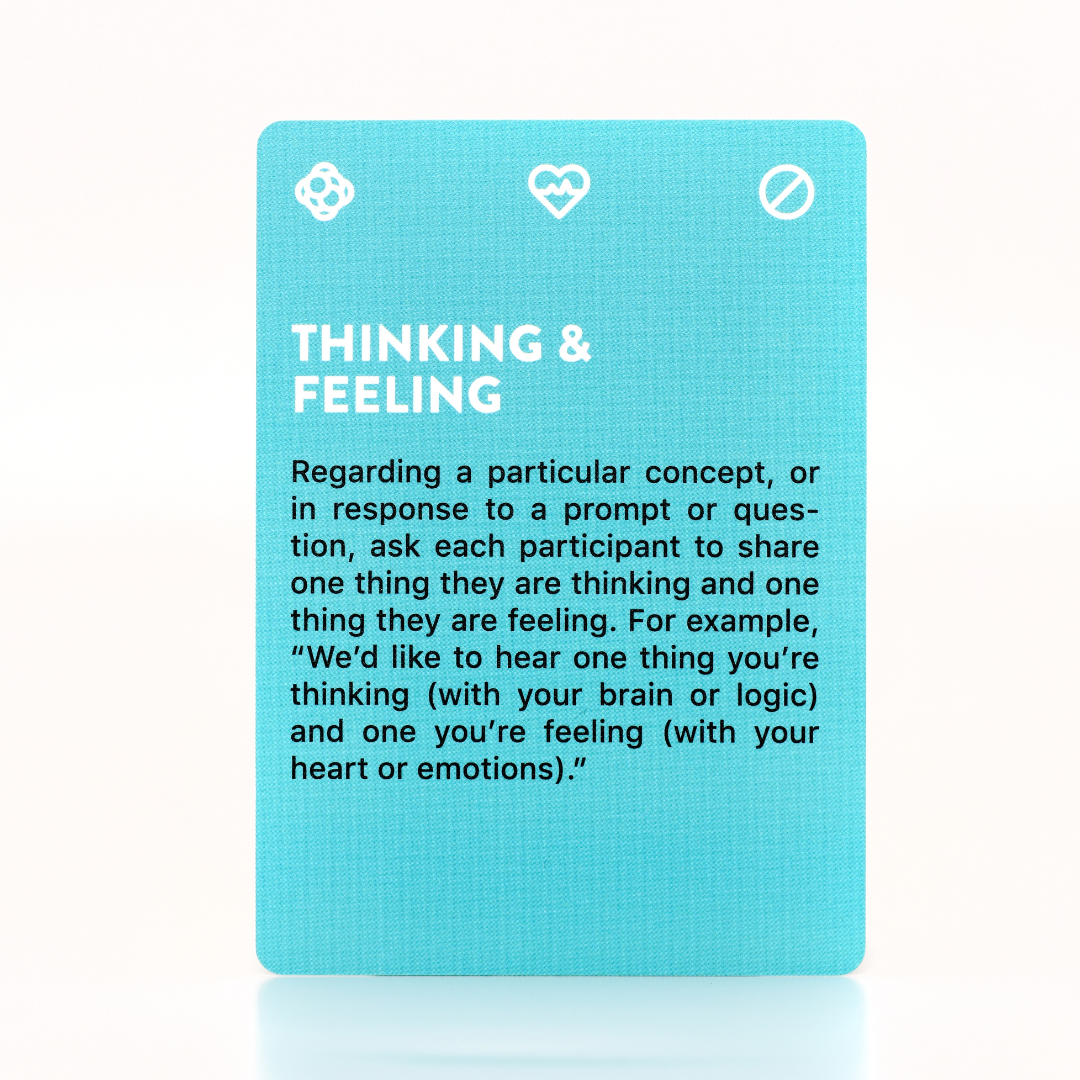Calling all logical and emotional thinkers!
Thinking & Feeling is a dynamic framework used to surface emotions. With these clear communication guidelines, the group knows exactly how to respond.
How It Works
Ask participants to speak to one thing they’re thinking and one thing they’re feeling in response to a prompt. By hearing from both perspectives, we mitigate some of the vulnerability participants might feel when asked to share their emotions with a group.
Oftentimes we ask for responses but don’t specify what shape we’d like those to take. This can lead to people feeling like it’s inappropriate to bring their emotional response to the table, or if everyone is trading in emotions our logical responses can suddenly seem clinical.
By narrowing the ask to just one response for both, folks are less pressured to try and sum up every response they’re having. They may be surprised when other parts of their responses are echoed back to them by others in the group!
When To Use
- Check-ins & icebreakers
- Before brainstorming to get a group consensus on goals
- Debriefs
- Reflect on a shared experience
- After a contentious conversation or debate
Prompts & Examples
Instead of asking, “How does everyone feel about ____” apply Thinking & Feeling to ask:
_“What is one thing you’re thinking and one thing you’re feeling about __”
As an icebreaker:
“What’s one thing you’re thinking and one thing you’re feeling about the room we’re meeting in today?”
Before brainstorming:
“Tell me one thing you’re thinking and one thing you’re feeling about what you hope we get out of making this mindmap.”
As a debrief:
“As we wrap up this conversation, I’d like to hear one thing you’re thinking and one thing you’re feeling about what we just discussed.”
For reflection:
“I would love to hear one thing you’re thinking and one thing you’re feeling about the chapter we read last night.”
Facilitator Tip! We usually ask for share-outs in the form of a Go-Around or Popcorn Share, but Thinking & Feeling can also make an excellent journaling prompt! Sharing emotions with the group can be highly vulnerable, but when it comes to reflection and understanding our reactions, admitting emotions to ourselves is often just as helpful.
Powerful Combinations
Thinking & Feeling + Airport Signs
Have participants make two separate signs. One listing one thing they’re thinking, the other one thing they’re feeling. In the first round have everyone walk around holding their “thinking” signs, then swap signs and repeat!
Thinking & Feeling + Timeline Map
Timeline Maps are often used to track events, but what if we purposefully included emotions?
Ask your participants to include the dominant emotion they associate with the events they’re describing on the map. It’s interesting to compare reactions people felt and helps them self-check on what supports would be best the next time that task is asked of them.
Thinking & Feeling + Sharing Withholds
Sharing Withholds is a powerful process that brings everything that’s been left unsaid to the table. By pairing it with Thinking & Feeling, the withholds speak to both so the group can express the emotions that have gone unsaid as well.
Why We 💙 It
The more specific we can be with instructions, the easier it is for participants to respond. Asking a group of adults to voice their emotions can be a tricky thing to balance, but by providing a logical buffer we mitigate some of that social risk.
